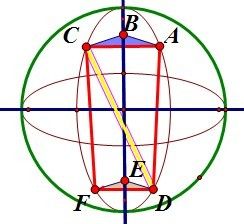UVa 11817 - Tunnelling the Earth
题目:给出地球上的两个点的经度和纬度,计算两点球面距离和两点的空间距离差。
分析:计算几何、大地坐标系。利用公式可直接解得两点的空间距离:
d = r*sqrt(2-2*(cos(lat1)*cos(lat2)*cos(lon1-lon2)+sin(lat1)*sin(lat2)))
推导过程如下:

如图,C,D为已知两点则有如下推导:
AB = r*cos(lat1);DE = r*cos(lat2);BE = r*sin(lat1) + r*sin(lat2);
AD*AD = BE*BE + (AB-DE)*(AB-DE) = 2*r*r - 2*r*r*sin(lat1)*sin(lat2) - 2*r*r*cos(lat1)*cos(lat2);
AC*AC = 2*AB*AB - 2*AB*AB*cos(lon1-lon2) = 2*r*r*cos(lat1)*cos(lat1)*(1-cos(lon1-lon2));
DF*DF = 2*DE*DE - 2*DE*DE*cos(lon1-lon2) = 2*r*r*cos(lat2)*cos(lat2)*(1-cos(lon1-lon2));
AC*DF = 2*r*r*cos(lat1)*cos(lat2)*(1-cos(lon1-lon2));
由托勒密定理有 AC*DF + AD*AD = CD*CD 整理有:
CD = r*sqrt(2-2*(cos(lat1)*cos(lat2)*cos(lon1-lon2)+sin(lat1)*sin(lat2)));
注意:输出最近的整数,%.0lf即可。
#include <stdio.h>
#include <stdlib.h>
#include <math.h>
int main()
{
double r = 6371009;
double p = acos(-1.0);
int n;
double l1,d1,l2,d2;
while ( scanf("%d",&n) != EOF )
while ( n -- ) {
scanf("%lf%lf%lf%lf",&l1,&d1,&l2,&d2);
l1 *= p/180.0; l2 *= p/180.0;
d1 *= p/180.0; d2 *= p/180.0;
double d = r*sqrt(2-2*(cos(l1)*cos(l2)*cos(d1-d2)+sin(l1)*sin(l2)));
printf("%.0lf\n",2*asin(d/(2*r))*r-d);
}
return 0;
}